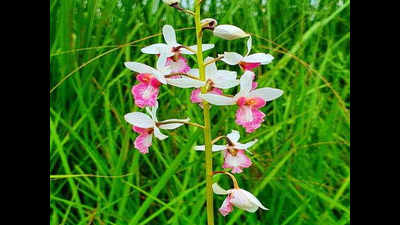- News
- City News
- bareilly News
- Rare orchid species now blooming at 47 locations
Trending
This story is from July 7, 2020
Rare orchid species now blooming at 47 locations
Days after the rediscovery of Eulophia obtuse, a rare orchid species, in India inside the dense forests of Dudhwa Tiger Reserve, officials have now spotted this critically endangered species at 47 other locations within the reserve. Field director Sanjay Pathak and deputy director Manoj Sonkar are in touch with several botanists across the globe and are planning to carry out research work for the conservation of this rare species in the country.

Eulophia obtuse
BAREILLY: Days after the rediscovery of Eulophia obtuse, a rare orchid species, in India inside the dense forests of Dudhwa Tiger Reserve, officials have now spotted this critically endangered species at 47 other locations within the reserve. Field director Sanjay Pathak and deputy director Manoj Sonkar are in touch with several botanists across the globe and are planning to carry out research work for the conservation of this rare species in the country.
Pathak told TOI, “We have now spotted this orchid species at 47 locations due to the efforts of deputy director Manoj Sonkar. We are continuously in touch with Mohammed Sharif and other botanists and will soon carry a detailed survey to take steps towards its conservation. WWF-India has also assured us required support in this initiative.”
Conservationist Fazlur Rahman, who was the first person to have clicked the picture, said, “I have been coordinating with the Dudhwa forest department for the past 15 years. These forests are full of amazing species and there are many secrets yet to be unveiled. I am sure that research work at Dudhwa by ace botanists and zoologists will deliver fruitful results.”
In India, the species — listed as ‘critically endangered’ in the IUCN Red List of Endangered Species — was last sighted in Pilibhit in 1902, according to the documented records in Kew Herbarium in England. The species was originally described from Uttarakhand in the 19th century. It was collected by botanists from Gangetic plains but there have been no sightings in the past 100 years. In 2008, the plant species was sighted in Bangladesh for the first time.
Pathak told TOI, “We have now spotted this orchid species at 47 locations due to the efforts of deputy director Manoj Sonkar. We are continuously in touch with Mohammed Sharif and other botanists and will soon carry a detailed survey to take steps towards its conservation. WWF-India has also assured us required support in this initiative.”
Conservationist Fazlur Rahman, who was the first person to have clicked the picture, said, “I have been coordinating with the Dudhwa forest department for the past 15 years. These forests are full of amazing species and there are many secrets yet to be unveiled. I am sure that research work at Dudhwa by ace botanists and zoologists will deliver fruitful results.”
In India, the species — listed as ‘critically endangered’ in the IUCN Red List of Endangered Species — was last sighted in Pilibhit in 1902, according to the documented records in Kew Herbarium in England. The species was originally described from Uttarakhand in the 19th century. It was collected by botanists from Gangetic plains but there have been no sightings in the past 100 years. In 2008, the plant species was sighted in Bangladesh for the first time.
A 2017 study published in Kew Bulletin – a peer-reviewed journal published by Springer – which had Mohammed Sharif as its first author had reported that Eulophia obtusa was under serious threat due to habitat loss and reduction in the number of mature individuals in Bangladesh.
End of Article
FOLLOW US ON SOCIAL MEDIA











